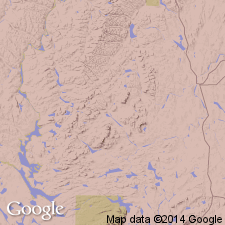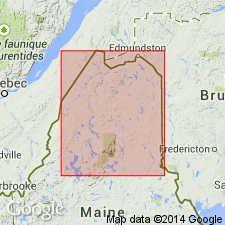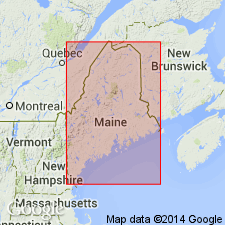
- Usage in publication:
-
- Rocky Mountain Quartz Latite
- Modifications:
-
- Named
- Dominant lithology:
-
- Quartz latite
- AAPG geologic province:
-
- New England province
Summary:
Felsic volcanic rocks, largely quartz latite, included by Boudette and others (1976) in their "Fivemile Brook sequence" are here mapped as a separate unit and named the Rocky Mountain Quartz Latite. It outcrops at Rocky Mountain, on the East and West Branches of Pocwock Stream, and north of Little Black River. May be genetically related to the Aquagene tuff member of the Depot Mountain Formation. Overlies and is interlayered with rocks similar to the Depot Mountain Formation; underlies rocks typical of the Fivemile Brook Formation. Thickness varies from 300 to 1,000 m. Age is probably Silurian.
Source: GNU records (USGS DDS-6; Reston GNULEX).

- Usage in publication:
-
- Rocky Mountain Quartz Latite
- Modifications:
-
- Overview
- AAPG geologic province:
-
- New England province
Summary:
Along the western slopes of Rocky Mountain the Depot Mountain Formation underlies the Rocky Mountain Quartz Latite, suggesting a possible temporal equivalency of the Rocky Mountain and the basaltic flows of the Fivemile Brook Formation. They are separately mapped because they are lithologically distinctive and the precise age range of the Rocky Mountain is unknown. Rocks mapped as Rocky Mountain by Roy (1980) near Rocky Brook are here assigned to the Aquagene tuff member of the Depot Mountain. The Rocky Mountain Quartz Latite contains no interbedded sedimentary rocks and is everywhere stratigraphically above the Depot Mountain. Underlies the Seboomook Formation along the Rocky Mountain fault. The Rocky Mountain and the Fivemile Brook may be of the same age, Late Silurian.
Source: GNU records (USGS DDS-6; Reston GNULEX).

- Usage in publication:
-
- Rocky Mountain quartz latite
- Modifications:
-
- Revised
- AAPG geologic province:
-
- New England province
Summary:
Informal name Rocky Mountain quartz latite is suggested for latitic rocks at Rocky Mountain and near Pockwock Stream, previously mapped as part of the Fivemile Brook sequence by Boudette (1976) or as a separate unit overlying the Fivemile Brook Formation (Roy, 1980; 1983). 1000 m of fragmental siliceous lithic and crystal tuffs with much less mafic rock are preserved in a syncline at Rocky Mountain. These volcanic rocks stratigraphically overlie and are parallel with the upper member of Depot Mountain Formation indicating a conformable (or disconformable) contact. No comparable rocks have been described along strike to the northeast or southwest. Age considered Late Silurian.
Source: GNU records (USGS DDS-6; Reston GNULEX).
For more information, please contact Nancy Stamm, Geologic Names Committee Secretary.
Asterisk (*) indicates published by U.S. Geological Survey authors.
"No current usage" (†) implies that a name has been abandoned or has fallen into disuse. Former usage and, if known, replacement name given in parentheses ( ).
Slash (/) indicates name conflicts with nomenclatural guidelines (CSN, 1933; ACSN, 1961, 1970; NACSN, 1983, 2005, 2021). May be explained within brackets ([ ]).

